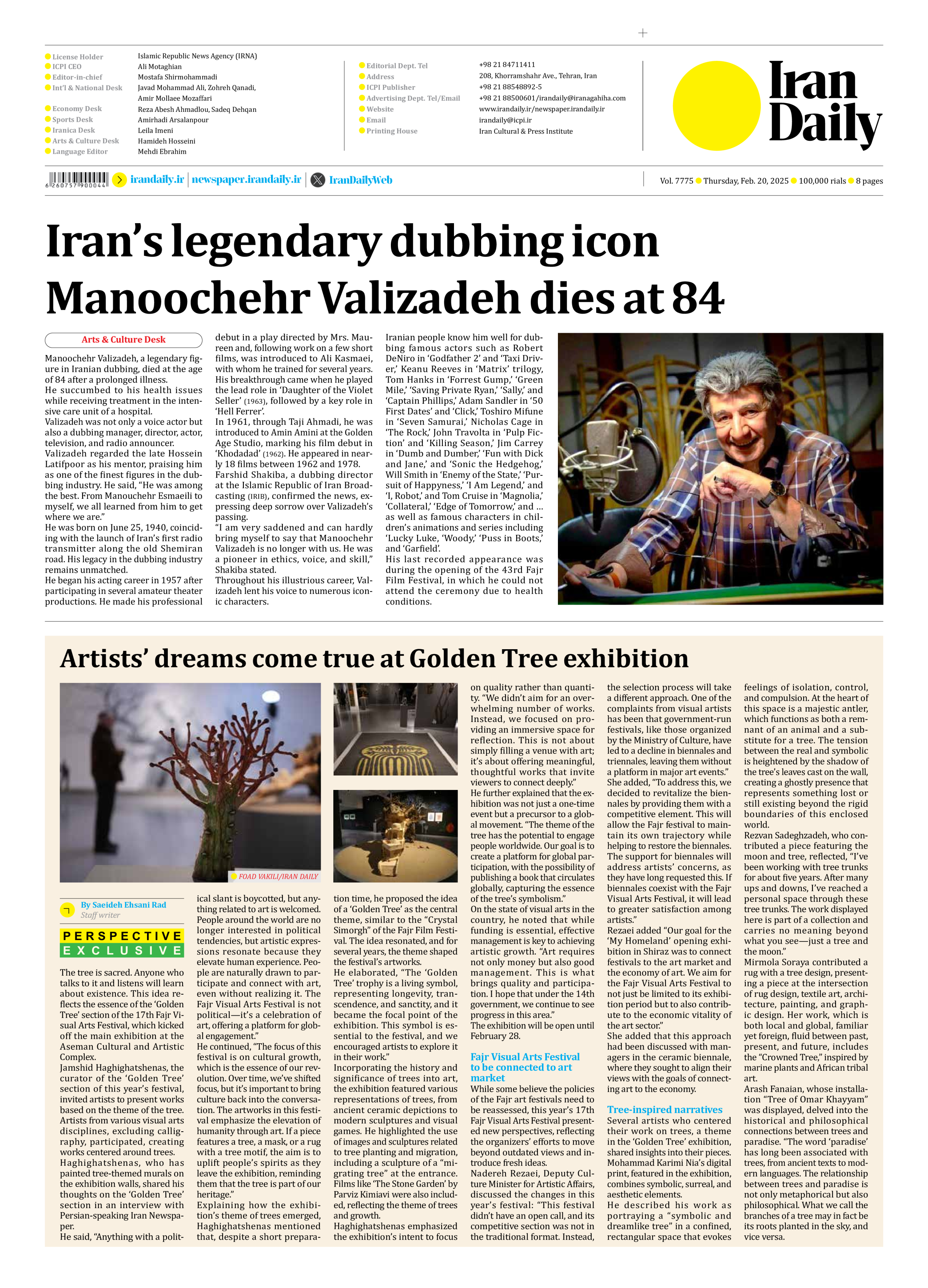
Artists’ dreams come true at Golden Tree exhibition
By Saeideh Ehsani Rad
Staff writer
The tree is sacred. Anyone who talks to it and listens will learn about existence. This idea reflects the essence of the ‘Golden Tree’ section of the 17th Fajr Visual Arts Festival, which kicked off the main exhibition at the Aseman Cultural and Artistic Complex.
Jamshid Haghighatshenas, the curator of the ‘Golden Tree’ section of this year’s festival, invited artists to present works based on the theme of the tree. Artists from various visual arts disciplines, excluding calligraphy, participated, creating works centered around trees.
Haghighatshenas, who has painted tree-themed murals on the exhibition walls, shared his thoughts on the ‘Golden Tree’ section in an interview with Persian-speaking Iran Newspaper.
He said, “Anything with a political slant is boycotted, but anything related to art is welcomed. People around the world are no longer interested in political tendencies, but artistic expressions resonate because they elevate human experience. People are naturally drawn to participate and connect with art, even without realizing it. The Fajr Visual Arts Festival is not political—it’s a celebration of art, offering a platform for global engagement.”
He continued, “The focus of this festival is on cultural growth, which is the essence of our revolution. Over time, we’ve shifted focus, but it’s important to bring culture back into the conversation. The artworks in this festival emphasize the elevation of humanity through art. If a piece features a tree, a mask, or a rug with a tree motif, the aim is to uplift people’s spirits as they leave the exhibition, reminding them that the tree is part of our heritage.”
Explaining how the exhibition’s theme of trees emerged, Haghighatshenas mentioned that, despite a short preparation time, he proposed the idea of a ‘Golden Tree’ as the central theme, similar to the “Crystal Simorgh” of the Fajr Film Festival. The idea resonated, and for several years, the theme shaped the festival’s artworks.
He elaborated, “The ‘Golden Tree’ trophy is a living symbol, representing longevity, transcendence, and sanctity, and it became the focal point of the exhibition. This symbol is essential to the festival, and we encouraged artists to explore it in their work.”
Incorporating the history and significance of trees into art, the exhibition featured various representations of trees, from ancient ceramic depictions to modern sculptures and visual games. He highlighted the use of images and sculptures related to tree planting and migration, including a sculpture of a “migrating tree” at the entrance. Films like ‘The Stone Garden’ by Parviz Kimiavi were also included, reflecting the theme of trees and growth.
Haghighatshenas emphasized the exhibition’s intent to focus on quality rather than quantity. “We didn’t aim for an overwhelming number of works. Instead, we focused on providing an immersive space for reflection. This is not about simply filling a venue with art; it’s about offering meaningful, thoughtful works that invite viewers to connect deeply.”
He further explained that the exhibition was not just a one-time event but a precursor to a global movement. “The theme of the tree has the potential to engage people worldwide. Our goal is to create a platform for global participation, with the possibility of publishing a book that circulates globally, capturing the essence of the tree’s symbolism.”
On the state of visual arts in the country, he noted that while funding is essential, effective management is key to achieving artistic growth. “Art requires not only money but also good management. This is what brings quality and participation. I hope that under the 14th government, we continue to see progress in this area.”
The exhibition will be open until February 28.
Fajr Visual Arts Festival to be connected to art market
While some believe the policies of the Fajr art festivals need to be reassessed, this year’s 17th Fajr Visual Arts Festival presented new perspectives, reflecting the organizers’ efforts to move beyond outdated views and introduce fresh ideas.
Nadereh Rezaei, Deputy Culture Minister for Artistic Affairs, discussed the changes in this year’s festival: “This festival didn’t have an open call, and its competitive section was not in the traditional format. Instead, the selection process will take a different approach. One of the complaints from visual artists has been that government-run festivals, like those organized by the Ministry of Culture, have led to a decline in biennales and triennales, leaving them without a platform in major art events.”
She added, “To address this, we decided to revitalize the biennales by providing them with a competitive element. This will allow the Fajr festival to maintain its own trajectory while helping to restore the biennales. The support for biennales will address artists’ concerns, as they have long requested this. If biennales coexist with the Fajr Visual Arts Festival, it will lead to greater satisfaction among artists.”
Rezaei added “Our goal for the ‘My Homeland’ opening exhibition in Shiraz was to connect festivals to the art market and the economy of art. We aim for the Fajr Visual Arts Festival to not just be limited to its exhibition period but to also contribute to the economic vitality of the art sector.”
She added that this approach had been discussed with managers in the ceramic biennale, where they sought to align their views with the goals of connecting art to the economy.
Tree-inspired narratives
Several artists who centered their work on trees, a theme in the ‘Golden Tree’ exhibition, shared insights into their pieces.
Mohammad Karimi Nia’s digital print, featured in the exhibition, combines symbolic, surreal, and aesthetic elements.
He described his work as portraying a “symbolic and dreamlike tree” in a confined, rectangular space that evokes feelings of isolation, control, and compulsion. At the heart of this space is a majestic antler, which functions as both a remnant of an animal and a substitute for a tree. The tension between the real and symbolic is heightened by the shadow of the tree’s leaves cast on the wall, creating a ghostly presence that represents something lost or still existing beyond the rigid boundaries of this enclosed world.
Rezvan Sadeghzadeh, who contributed a piece featuring the moon and tree, reflected, “I’ve been working with tree trunks for about five years. After many ups and downs, I’ve reached a personal space through these tree trunks. The work displayed here is part of a collection and carries no meaning beyond what you see—just a tree and the moon.”
Mirmola Soraya contributed a rug with a tree design, presenting a piece at the intersection of rug design, textile art, architecture, painting, and graphic design. Her work, which is both local and global, familiar yet foreign, fluid between past, present, and future, includes the “Crowned Tree,” inspired by marine plants and African tribal art.
Arash Fanaian, whose installation “Tree of Omar Khayyam” was displayed, delved into the historical and philosophical connections between trees and paradise. “The word ‘paradise’ has long been associated with trees, from ancient texts to modern languages. The relationship between trees and paradise is not only metaphorical but also philosophical. What we call the branches of a tree may in fact be its roots planted in the sky, and vice versa.







